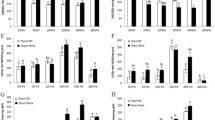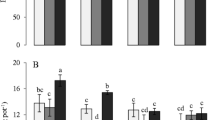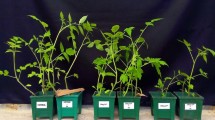Abstract
Fresh surface water supplies are gradually becoming insufficient in arid and semi-arid regions of the world. Thus, farmers in these areas are being forced to use poor quality sewage water. Irrigating vegetable crops with sewage water having high metal concentration may affect growth and biochemical processes of plants. Biochar (BC) can sorb these metals and may reduce their toxic effects on plants. Thus, a greenhouse experiment was conducted to study the influence of cotton stalks derived biochar (CSDB) at control (0%) and 1%; ground water (GW; 0.01 ppm Cd); cadmium-contaminated water (CCW; 2 ppm Cd); and sewage water (SW; 0.13 ppm Cd) on growth and biochemical processes of tomato (Solanum lycopersicum) plants. On an average, additions of 1% BC significantly (p ≤ 0.05) enhanced dry weight of roots (36%) and shoots (52%) of plants as compared to without BC application. Biochar (1%) decreased shoot Cd concentration by 33% at SW and 100% at CCW. The Cd uptake was increased by 33% with the BC + CCW treatment. Soil organic matter (SOM) was increased 1.2 times while pH and EC were increased by 5 and 47%, respectively, in 1% BC amended soil. Biochar application alleviated toxic effects of Cd and improved growth as well as productions of photosynthetic and accessory pigments in tomato plants.










Similar content being viewed by others
References
Abbas M, Parveen Z, Iqbal M, Riazuddin M, Iqbal S, Ahmed M, Bhutto R (2010) Monitoring of toxic metals (cadmium, lead, arsenic and mercury) in vegetables of Sindh, Pakistan. Kathmandu Univ J Sci Eng Technol 6:60–65
Adriano DC, Wenzel WW, Vangronsveld J, Bolan NS (2004) Role of assisted natural remediation in environmental cleanup. Geoderma 122:121–142
Ahmad M, Rajapaksha AU, Lim JE, Zhang M, Bolan N, Mohan D, Vithanage M, Lee SS, Ok YS (2014) Biochar as a sorbent for contaminant management in soil and water: a review. Chemosphere 99:19–33
Amonette JE, Joseph S (2009) Characteristics of biochar: micro-chemical properties. In: Amonette J, Joseph S (eds) Biochar for environmental management: science and technology. Earthscan, London, pp 33–52
Arnon DI (1949) Copper enzymes in isolated chloroplasts. Polyphenoloxidase in Beta vulgaris. Plant Physiol 24:1–15
Beesley L, Marmiroli M (2011) The immobilisation and retention of soluble arsenic, cadmium and zinc by biochar. Environ Pollut 159:474–480
Chapman H, Pratt P (1962) Methods of analysis for soils, plants and waters. Soil Science 93:1–68
Chen C-Y, Yeh K-L, Aisyah R, Lee D-J, Chang J-S (2011) Cultivation, photobioreactor design and harvesting of microalgae for biodiesel production: a critical review. Bioresour Technol 102:71–81
Cui L, Pan G, Li L, Yan J, Zhang A, Bian R, Chang A (2012) The reduction of wheat Cd uptake in contaminated soil via biochar amendment: a two-year field experiment. Bioresources 7:5666–5676
Curaqueo G, Meier S, Khan N, Cea M, Navia R (2014) Use of biochar on two volcanic soils: effects on soil properties and barley yield. J Soil Sci Plant Nutr 14:911–924
Fiaz K, Danish S, Younis U, Malik S, Raza Shah M, Niaz S (2014) Drought impact on Pb/Cd toxicity remediated by biochar in Brassica campestris. J Soil Sci Plant Nutr 14:845–854
Gao X, Wu P, Zhao X, Wang J, Shi Y (2014) Effects of land use on soil moisture variations in a semi-arid catchment: implications for land and agricultural water management. Land Degrad Dev 25:163–172
Gee GW, Bauder JW (1986) Particle-size analysis. In: Gee GW, Bauder JW (eds) Methods of soil analysis. Part 1. Physical and mineralogical methods. Soil Sci. Soc. Amer., Amer. Soc. Agron., Madison, pp 383–411
Giovannucci E (1999) Tomatoes, tomato-based products, lycopene, and cancer: review of the epidemiologic literature. J Natl Cancer Inst 91:317–331
Hubbell JN, William RD, Lin SM, Roan YC, Hsu HA (1979) 1st International Symposium on Tropical Tomato. In: International Conference on the Processing Tomato (1st: 1996: Recife, Brazil). ASHS Press, Alexandria, Virginia, pp 154–166
Iannelli MA, Pietrini F, Fiore L, Petrilli L, Massacci A (2002) Antioxidant response to cadmium in Phragmites australis plants. Plant Physiol Biochem 40:977–982
Jackson ML (1975) Soil chemical analysis. Advanced Course. University of Wisconsin, College of Agriculture, Department of Soils, Madison, Wisconsin, pp 894
Järup L (2003) Hazards of heavy metal contamination. Br Med Bull 68:167–182
Jego G, Rotz CA, Belanger G, Tremblay GF, Charbonneau E, Pellerin D (2015) Simulating forage crop production in a northern climate with the Integrated Farm System Model. Can J Plant Sci 95:745–757
Lamoreaux RJ, Chaney WR (1978) The effect of cadmium on net photosynthesis, transpiration, and dark respiration of excised silver maple leaves. Physiol Plant 43:231–236
Liang X, Han J, Xu Y, Sun Y, Wang L, Tan X (2014) In situ field-scale remediation of Cd polluted paddy soil using sepiolite and palygorskite. Geoderma 235–236:9–18
Noor NM, Shariff A, Abdullah N (2012) Slow pyrolysis of cassava wastes for biochar production and characterization. Iran J Energy Environ (Spec Issue Environ Technol) 3:60–65
Pan Y, Bonten LT, Koopmans GF, Song J, Luo Y, Temminghoff EJ, Comans RN (2016) Solubility of trace metals in two contaminated paddy soils exposed to alternating flooding and drainage. Geoderma 261:59–69
Park JH, Choppala GK, Bolan NS, Chung JW, Chuasavathi T (2011) Biochar reduces the bioavailability and phytotoxicity of heavy metals. Plant Soil 348:439. doi:10.1007/s11104-011-0948-y
Qayyum MF, Abid M, Danish S, Saeed MK, Ali MA (2015) Effects of various biochars on seed germination and carbon mineralization in an alkaline soil. Pakistan J Agric Sci 51:977–982
Radwan MA, Salama AK (2006) Market basket survey for some heavy metals in Egyptian fruits and vegetables. Food Chem Toxicol 44:1273–1278
Ravelo-Pérez LM, Hernández-Borges J, Rodríguez-Delgado MÁ, Borges-Miquel T (2008) Spectrophotometric analysis of lycopene in tomatoes and watermelons In: A practical class. The Chemical Educator 13:11–13
Rizwan M, Ali S, Qayyum MF, Ibrahim M, Zia-ur-Rehman M, Abbas T, Ok YS (2016) Mechanisms of biochar-mediated alleviation of toxicity of trace elements in plants: a critical review. Environ Sci Pollut Res 23:2230–2248
Rondon MA, Lehmann J, Ramírez J, Hurtado M (2007) Biological nitrogen fixation by common beans (Phaseolus vulgaris L.) increases with bio-char additions. Biol Fertil Soils 43:699–708
Shaaban M, Abid M, Abou-Shanab R (2013a) Amelioration of salt affected soils in rice paddy system by application of organic and inorganic amendments. Plant Soil Environ 59:227–233
Shaaban M, Abid M, Qi-An P (2013b) Short term influence of gypsum, farm manure and commercial humic acid on physical properties of salt affected soil in rice paddy system. J Chem Soc Pak 35:1034–1040
Siddiqui S, Meghvansi MK, Wani MA, Jabee F (2009) Evaluating cadmium toxicity in the root meristem of Pisumsativum L. Acta Physiol Plant 31:531
Soltanpour PN (1985) Use of ammonium bicarbonate DTPA test to evaluate elemental availability and toxicity. Commun Soil Sci Plant Anal 16:323–338
Steenland K, Boffetta P (2000) Lead and cancer in humans: where are we now? Am J Ind Med 38:295–299
Steiner C, Glaser B, Geraldes Teixeira W, Lehmann J, Blum WE, Zech W (2008) Nitrogen retention and plant uptake on a highly weathered central Amazonian Ferralsol amended with compost and charcoal. J Plant Nutr Soil Sci 171:893–899
Sun Y, Zhou Q, Diao C (2008) Effects of cadmium and arsenic on growth and metal accumulation of Cd-hyperaccumulator Solanum nigrum L. Bioresour Technol 99:1103–1110
Uchimiya M, Lima IM, Klasson KT, Wartelle LH (2010a) Contaminant immobilization and nutrient release by biochar soil amendment: roles of natural organic matter. Chemosphere 80:935–940
Uchimiya M, Lima IM, Thomas Klasson K, Chang S, Wartelle LH, Rodgers JE (2010b) Immobilization of heavy metal ions (CuII, CdII, NiII, and PbII) by broiler litter-derived biochars in water and soil. J Agric Food Chem 58:5538–5544. doi:10.1021/jf9044217
Verheijen F, Jeffery S, Bastos A, Van der Velde M, Diafas I (2010) Biochar application to soils: a critical scientific review of effects on soil properties, processes and functions. Joint Research Centre Scientific and Technical Reports, Italy. http://ies.jrc.ec.europa.eu/
Vidal C, Chantreuil C, Berge O, Maure L, Escarre J, Bena G, Brunel B, Cleyet-Marel J-C (2009) Mesorhizobium metallidurans sp. nov., a metal-resistant symbiont of Anthyllis vulneraria growing on metallicolous soil in Languedoc, France. Int J Syst Evol Microbiol 59:850–855
Wang L, Zhou Q, Ding L, Sun Y (2008) Effect of cadmium toxicity on nitrogen metabolism in leaves of Solanum nigrum L. as a newly found cadmium hyperaccumulator. J Hazard Mater 154:818–825
Younis U, Danish S, Shah MHR, Malik SA (2014) Nutrient shifts modeling in Spinacea oleracea L. and Trigonella corniculata L. in contaminated soil amended with biochar. Int J Biosci 5:89–98
Yuan J-H, Xu R-K, Zhang H (2011) The forms of alkalis in the biochar produced from crop residues at different temperatures. Bioresour Technol 102:3488–3497
Zemanová V, Trakal L, Ochecova P, Száková J, Pavlíková D (2014) A model experiment: competitive sorption of Cd, Cu, Pb and Zn by three different soils. Soil Water Res 9:97–103
Acknowledgements
We acknowledge Higher Education Commission (Pakistan) for the financial support.
Author information
Authors and Affiliations
Corresponding authors
Additional information
Responsible editor: Philippe Garrigues
Rights and permissions
About this article
Cite this article
Abid, M., Danish, S., Zafar-ul-Hye, M. et al. Biochar increased photosynthetic and accessory pigments in tomato (Solanum lycopersicum L.) plants by reducing cadmium concentration under various irrigation waters. Environ Sci Pollut Res 24, 22111–22118 (2017). https://doi.org/10.1007/s11356-017-9866-8
Received:
Accepted:
Published:
Issue Date:
DOI: https://doi.org/10.1007/s11356-017-9866-8




